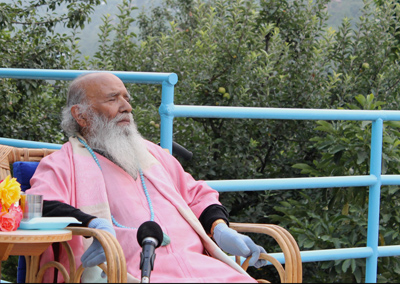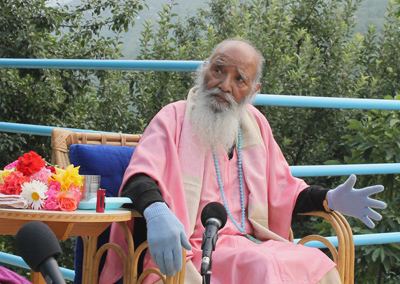It Is Whatever Remains

Your ears can hear. And everybody’s mouth can speak. I, with the body, can also use the mouth to speak. I can use the eyes to see. I can use the ears to hear. I can use the nose to smell. I can use the tongue to taste. As well, I can use the mouth, tongue, lips and throat, all taken together, to create speech. When I am quiet, then thinking is initiated—but before that, there is nothing to describe to a human being. There is nothing for a human being to hear. For the eyes, there is nothing to see. For the ears, there is nothing to hear. For the nose, there is no smell. For the tongue, there is no taste. For the fingers or hands, there is nothing to touch or clasp. For the feet, there is nothing to walk on—no action. And you have that power which knows what has been said.
Pure Free Forever. Amaram Hum Madhuram Hum. This is not a quotation from any person. Rather, it is always ever-present in all of you. It is always ever-present in all sentient beings, and in all insentient beings. It is always ever-present in all of prakriti, or nature—in all forms.
When the tongue does not have any ability, or gati (movement), or power, it has to be quiet. But that is not the end. That is not the beginning. That is not zero. That is not figures. That is not not-zero. That is not the sky. That is not the knowing power, chaytan, or consciousness. And that is not alone. That is all. Full stop. But it is not that a full stop cannot be removed. Yet that is not flow. That is not unflow.
That is not chaytan, or conscious. That is not unconscious. That is not conscious unconsciousness—or unconscious consciousness. That is not the birth of a human being. That is not the death or end of a human being—or of any being, or of any form. Ever-present is not time. It is not space. It is not past, present and future. It is not words. It is not silence. Still, it remains.
Yet open the eyes [meditation had been going on]. It is bhasaman (appearance). It is not going home. It is not coming. Yet it is a dream. It is not a dream. It is the waking state. And it is not the waking state. It is sleep. And it is not deep sleep. It is not forgetfulness, and it is not not-forgetfulness. It is not knowledge—and it is not ignorance. It is not knowledge and ignorance together. It is not unknowledge and unignorance. Whatever can be located by the senses, by the mind, it is not. It is Immortal. It is Blissful. It is not Immortal. It is not Blissful. It is not Amaram (Immortal). It is not Madhuram (Blissful). It is not dwait (duality). It is not adwait (non-duality). It is not dwait-adwait. It is not “is.” It is not “is not.” It is whatever remains.
 So the dream is a bhasaman (appearance). And when the dream is not, it remains. The waking state is bhasaman. When bhasaman is not, it remains. It is prakash (light). Prakash does not remain, it remains.
So the dream is a bhasaman (appearance). And when the dream is not, it remains. The waking state is bhasaman. When bhasaman is not, it remains. It is prakash (light). Prakash does not remain, it remains.
Human beings are human beings. Animals are animals. All that which is on the back of an animal, inside an animal, that is an animal. All that which is on the back of the form of a human being and inside a human being, that is a human being. If it is a sun, inside and outside is sun. If it is a river, inside and outside is river. If it is a mountain, inside and outside is mountain. And when there is no inside or outside of any form, still it remains, remains, remains.
It is nothing to be quoted about, because there is nobody to quote. [Laughter] It remains, remains, remains. That means that is the siddhant (principle), because there is no kal, no time—no long time, no short time, no moment, no millennium. It remains, remains, remains. Millions of years pass, it has never been exhausted with that past. Millions of years happened, but it never happened because millions of years happened. Millions of years will again happen, but it will not happen. Millions of years will not remain in time and space, but it will remain. It remains, remains, remains.
I simply call for you to hear Amaram Hum Madhuram Hum, Amaram Hum Madhuram Hum.
Sing those seven Gita verses [Gita 2:19-25.The group starts with Ya Aynam Vaytti Hantaram Yash-chainam Manyatay Hatam, Ubhau Tau Na Vijaneeto Nayam Hanti Na Hanyatay, Gita 2:19.] Here he is saying that this is bhasaman (appearance), so it cannot be killed. It cannot be used. It cannot be.
[Gita 2:20 and 2:21 are sung, both of which Swamiji translates as “It remains, remains, remains.” Gita 2:22 to 2:24 are then sung. Finally, the group sings the last verse of the seven, Avyakto-ayam-achintyo-ayam Avikaryo-ayam-uchyatay, Tasmad-ayvam Viditwainam Nanushochitum-arhasi, or Gita 2:25. Swamiji has translated this as: After hearing me, you should know the Self is invisible and cannot be grasped by the thoughts of your mind. It is pure, free, forever. I know, and I am saying that it cannot be known by people with the intellect, which is a form, because the Self is pure, free from any modification. You should realize That, whose description I have given you. And knowing That, you are not supposed to become the type of person who will lament or have a sense of grief at its destruction, because it is indestructible.] So Arjun is being told here, “It remains, it remains, it remains.” Thus, Krishna says, “Nanushochitum-arhasi (Grieve not).”
That which is in between—which appears and which disappears—is bhasaman. Whose bhasaman? That which remains, remains, remains—forever. Thank you very much. [Applause]
Copyright © 1999-2014 International
Meditation Institute. All Rights Reserved